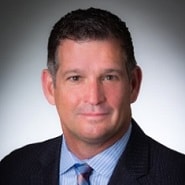
Andy Crowder, SVP & Chief Information and Analytics Officer, Atrium Health
To say that the healthcare landscape has changed during the past two years is putting it extremely mildly. Leaders were already facing myriad challenges before Covid-19 hit — from recruiting and retaining top talent to preventing cybersecurity breaches. The pandemic only intensified things.
However, it also ushered in an era of digital transformation that had been years in the making, and demonstrated the enormous potential that virtual health has to help alleviate some of the pressures. It also reaffirmed how critical it is for decision-makers to collaborate, according to Andy Crowder, Chief Information and Analytics Officer at Atrium Health.
“We have to have conversations with our colleagues,” he said. “We’re better together.”
During the panel at ViVE, Crowder spoke with three highly respected leaders — Stephanie Lahr, CIO and CMIO, Monument Health; Zafar Chaudry, MD, CIO at Seattle Children’s; and Angela Diop, VP of IS at Unity Health Care — about how they’re approaching the biggest issues facing their organizations.
Below are some highlights from the discussion, which can be accessed in an archived format for those who registered for the event.
Digital acceleration: “Ready for prime time”

Stephanie Lahr, MD, CIO and CMIO at Monument Health
Whereas in the past, many organizations have had an EHR-centric strategy, now it’s about identifying tools that can help improve efficiency and enhance engagement, said Lahr. “The most exciting thing from my perspective as a clinician is that it feels like those tools are finally ready for prime time. We’re seeing so much development in automation and in ambient technologies that can really help our clinicians deliver care and our patients become better engaged. It’s a super exciting time to see all these tools come together.” Some of the areas that could benefit including revenue cycle, care delivery and decision support, Lahr noted. “There’s so much happening in this space.”
Narrowing the digital divide
There is, however, a downside to digital transformation, according to Chaudry. “We’ve seen a level of inequity that has hasn’t come to light before. Not all of our patients have access to hardware. Not all of them have access to the right internet connection.” As a result, leaders need to think out of the box, which Seattle Children’s is doing by launching loaner programs for devices and connectivity “for all the communities we serve.”

Angela Diop, VP of Information Services, Unity Health Care
At Unity Health Care, which is a Federally Qualified Health Center, “the pandemic certainly shined a light on all of the places where we have significant health inequities,” said Diop, who urged attendees to push for continued government funding for telehealth programs, especially for urban communities. “We’re looking to bring our patients along with us in this journey. It’s going to improve access to care and quality of care.”
Supporting remote teams: “You still need interaction”
At Seattle Children’s, recruitment and retention have become increasingly difficult since the start of Covid, despite the fact that a large percentage of the workforce is remote, including those in support services. One of the reasons for dissatisfaction, Chaudry has found, is the isolation many feel when confined to their homes. “You still need that interaction,” he noted, which, for many leaders, will require stepping outside of their comfort zones. “You have to change how you interact with your teams. You have to check in, whereas before you could stop by a cubicle. Things have changed.”
It’s an area where digital tools can be leveraged, according to Lahr, who has certainly dealt with these challenges being based in a rural area. “We’re looking at tools around automation and looking to find ways that we can reduce friction and make things easier for our clinicians and for other caregivers.” And although offering hybrid options can help keep people, it isn’t always the best way to spart creativity. “It’s about more than just where you work,” she added. “We’re going to have to start thinking about when people work, how long people work, and what type of work they’re doing, and how we can leverage technology to remove the high-friction, frustrating elements.”
Opening up about burnout

Zafar Chaudry, MD, SVP & CIO, Seattle Children’s
One of the difficult aspects in assessing satisfaction and preventing burnout, according to Chaudry, is getting people to open up and ask for help. His approach is to be transparent about his frustrations, which doesn’t come naturally to most leaders. “You don’t want them to know you have weaknesses,” he noted. “But you have to talk about it, because if you don’t, you can’t expect people to talk about their problems.”
Time for a refresher
Diop, who has been with Unity for 14 years, is no stranger to burnout. The best way to address it, she believes, is by “refreshing yourself,” which she does by attending networking events, and extending similar opportunities to your teams. “I’m looking at each of my individual people and making sure we’re doing those things we couldn’t do for the last year or two, which is getting them out to training activities.”
Bringing back the fun
Lahr is a big proponent of creating a team atmosphere that’s not just productive, but also fun. At Monument, “we play games. We have baking competitions,” she said. During the holidays, they started a tradition of ‘elfing’ people by either sending packages to their homes, or decorating their workspaces. “There’s a lot that can be done, even remotely, to make things fun.”


Share Your Thoughts
You must be logged in to post a comment.